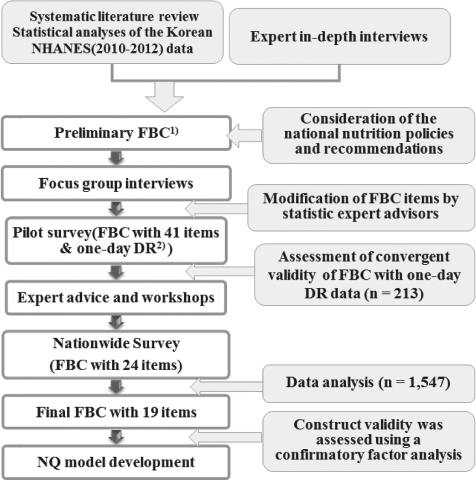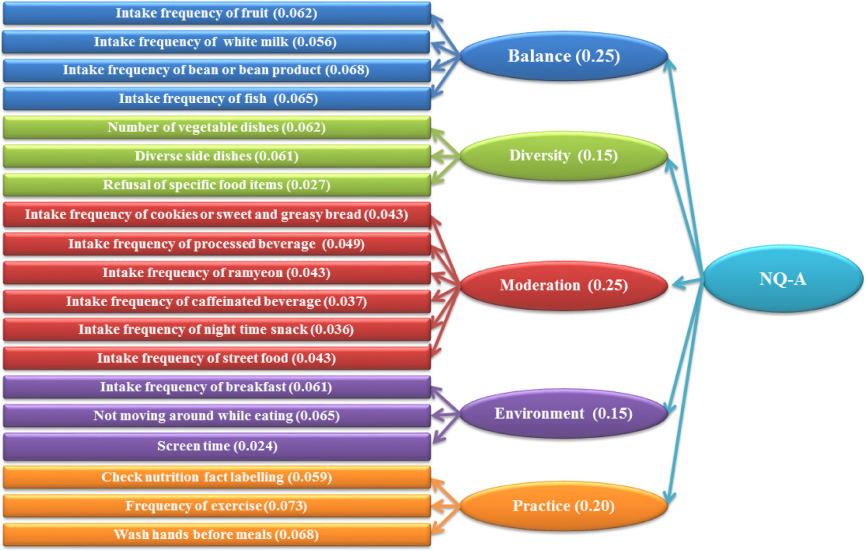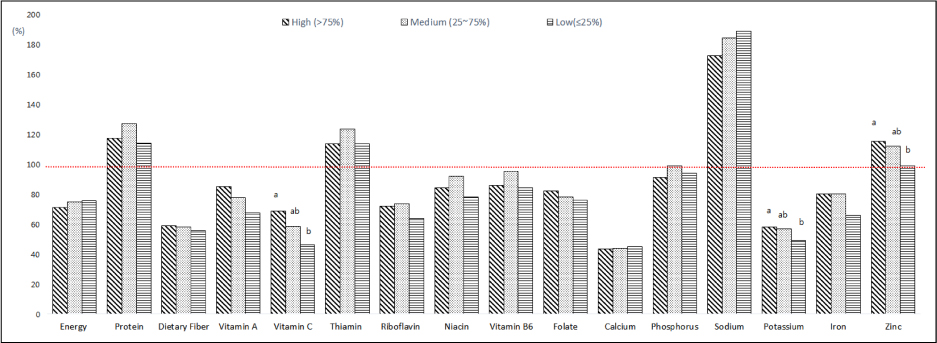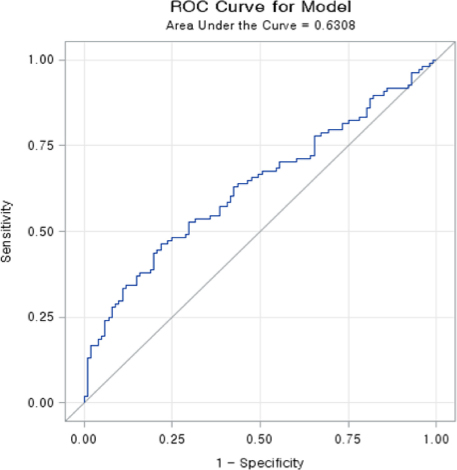Development of NQ-A, Nutrition Quotient for Korean Adolescents, to assess dietary quality and food behavior
- Affiliations
-
- 1Department of Food & Nutrition, Yongin University, Yongin 17092, Korea.
- 2Department of Food & Nutrition, Kookmin University, Seoul 02707, Korea.
- 3Department of Foodservice Management and Nutrition, Sangmyung University, Seoul 03016, Korea.
- 4Department of Statistics, Hannam University, Daejeon 34430, Korea.
- 5Nutrition for the Future Inc., Seoul 08788, Korea.
- 6Department of Food & Nutrition, Yonsei University, Seoul 03722, Korea.
- 7Department of Food & Nutrition, Hannam University, Daejeon 34430, Korea.
- 8Department of Food & Nutrition, Daegu University, Daegu 38453, Korea. yschoi@daegu.ac.kr
- KMID: 2407328
- DOI: http://doi.org/10.4163/jnh.2017.50.2.142
Abstract
- PURPOSE
The purpose of this study was to develop a nutrition quotient for adolescents (NQ-A) to assess overall dietary quality and food behavior of Korean adolescents.
METHODS
Development of the NQ-A was undertaken in three steps: item generation, item reduction, and validation. Candidate items of the NQ-A checklist were selected based on literature reviews, results of the fifth Korea National Health and Nutrition Examination Survey data, dietary guidelines for Korean adolescents, expert in-depth interviews, and national nutrition policies and recommendations. A total of 213 middle and high school students participated in a one-day dietary record survey and responded to 41 items in the food behavior checklist. Pearson's correlation coefficients between the responses to the checklist items along with nutritional status of the adolescents were calculated. Item reduction was performed, and 24 items were selected for the nation-wide survey. A total of 1,547 adolescents from 17 cities completed the checklist questionnaire. Exploratory factor and confirmatory factor analyses were performed to develop a final NQ-A model.
RESULTS
Nineteen items were finalized as the checklist items for the NQ-A. Checklist items were composed of five factors (balance, diversity, moderation, environment, and practice). The five-factor structure accounted for 47.2% of the total variance. Standardized path coefficients were used as weights of the items. The NQ-A and five-factor scores were calculated based on the obtained weights of the questionnaire items.
CONCLUSION
Nutrition Quotient for adolescents (NQ-A) would be a useful instrument for evaluating dietary quality and food behavior of Korean adolescents. Further research on NQ-A is needed to reflect changes in adolescent's food behavior and environment.
MeSH Terms
Figure
Cited by 7 articles
-
Study on Middle and High School Students' Use of Convenience Foods at Convenience Stores in Incheon
Seul-Ki Lee, Mi-Kyeong Choi, Mi-Hyun Kim
Korean J Community Nutr. 2019;24(2):137-151. doi: 10.5720/kjcn.2019.24.2.137.Development of Nutrition Quotient for Korean adults: item selection and validation of factor structure
Jung-Sug Lee, Hye-Young Kim, Ji-Yun Hwang, Sehyug Kwon, Hae Rang Chung, Tong-Kyung Kwak, Myung-Hee Kang, Young-Sun Choi
J Nutr Health. 2018;51(4):340-356. doi: 10.4163/jnh.2018.51.4.340.Association between frequency of convenience foods use at convenience stores and dietary quality among high school students in Incheon
Eun-Mi Kim, Mi-Kyeong Choi, Mi-Hyun Kim
J Nutr Health. 2019;52(4):383-398. doi: 10.4163/jnh.2019.52.4.383.Development of NQ-E, Nutrition Quotient for Korean elderly: item selection and validation of factor structure
∗
Min-Jae Chung, Kwak Tong-Kyung, Hye-Young Kim, Myung-Hee Kang, Jung-Sug Lee, Hae Rang Chung, Sehyug Kwon, Ji-Yun Hwang, Young-Sun Choi
J Nutr Health. 2018;51(1):87-102. doi: 10.4163/jnh.2018.51.1.87.Evaluation of the nutrient quotient for the elderly (NQ-E) using congregate meal services according to their oral health conditions
Na-Young Yi, Jung-Hwa Choi
Nutr Res Pract. 2022;16(5):628-645. doi: 10.4162/nrp.2022.16.5.628.Exploring the potential utility of a single-item perceived diet quality measure
Soo Hyun Kim, Hyojee Joung, Seul Ki Choi
Nutr Res Pract. 2024;18(6):845-856. doi: 10.4162/nrp.2024.18.6.845.Association between sleep timing shifts and dietary quality in Korean high school girls during COVID-19: a cross-sectional study
Mi-Hyun Kim, Youbeen Jung, Eunju Kim
Nutr Res Pract. 2025;19(2):292-304. doi: 10.4162/nrp.2025.19.2.292.
Reference
-
1. Bae YJ. Evaluation of nutrient intake and food variety by age in Korean adolescents: based on 2010-2012 Korean National Health and Nutrition Examination Survey. J Nutr Health. 2015; 48(3):236–247.
Article2. Kim MJ, Song S, Park SH, Song Y. The association of snack consumption, lifestyle factors, and pediatric obesity with dietary behavior patterns in male adolescents. J Nutr Health. 2015; 48(3):228–235.
Article3. Woo T, Lee HJ, Lee KA, Lee SM, Lee KH. Gender differences in adolescents' dietary perceptions and practices. Korean J Community Nutr. 2016; 21(2):165–177.
Article4. Bae YJ, Yeon JY. A Study on nutritional status and dietary quality according to carbonated drink consumption in male adolescents: based on 2007-2009 Korean National Health and Nutrition Examination Survey. J Nutr Health. 2015; 48(6):488–495.
Article5. Kwak S, Woo T, Lee KA, Lee KH. A comparison of dietary habits and influencing factors for vegetable preferences of adolescents in Gyeongnam province. Korean J Community Nutr. 2015; 20(4):259–272.
Article6. Kwon JE, Park HJ, Lim HS, Chyun JH. The relationships of dietary behavior, food intake, and life satisfaction with family meal frequency in middle school students. Korean J Food Cult. 2013; 28(3):272–281.
Article7. Bae YJ. Evaluation of nutrient intake and meal variety with breakfast eating in Korean adolescents: analysis of data from the 2008-2009 National Health and Nutrition Survey. Korean J Community Nutr. 2013; 18(3):257–268.
Article8. Bae YJ. Evaluation of nutrient intake and anthropometric parameters related to obesity in Korean female adolescents according to dietary diversity score: from the Korean National Health and Nutrition Examination Surveys, 2007-2009. Korean J Community Nutr. 2012; 17(4):419–428.
Article9. Jo JE, Park HR, Jeon SB, Kim JS, Park GE, Li Y, Lim YS, Hwang J. A study on relationship between socio-demographic factors and food consumption frequencies among adolescents in South Korea: using the Korea Youth Risk Behavior Web-based Survey from 2011. Korean J Community Nutr. 2013; 18(2):165–176.
Article10. Kim SH, Cho SW, Hwang SS, Ahn M, Lee D, Kang SW, Park YK. Increased whole grain, fruits and vegetable intake reduced oxidative stress in high school students. Korean J Nutr. 2012; 45(5):452–461.
Article11. Heo GJ, Nam SY, Lee SK, Chung SJ, Yoon JH. The relationship between high energy/low nutrient food consumption and obesity among Korean children and adolescents. Korean J Community Nutr. 2012; 17(2):226–242.
Article12. Kang MH, Lee JS, Kim HY, Kwon S, Choi YS, Chung HR, Kwak TK, Cho YH. Selecting items of a food behavior checklist for the development of nutrition quotient (NQ) for children. Korean J Nutr. 2012; 45(4):372–389.
Article13. Kim HY, Kwon S, Lee JS, Choi YS, Chung HR, Kwak TK, Park J, Kang MH. Development of a nutrition quotient (NQ) equation modeling for children and the evaluation of its construct validity. Korean J Nutr. 2012; 45(4):390–399.
Article14. Yoo JS, Choi YS. Evaluation of items for the food behavior checklist and nutrition quotient score on children in rural areas of Gyeongbuk. J Nutr Health. 2013; 46(5):427–439.
Article15. Boo MN, Cho SK, Park K. Evaluation of dietary behavior and nutritional status of elementary school students in Jeju using nutrition quotient. J Nutr Health. 2015; 48(4):335–343.
Article16. Lim H, Kim J, Wang Y, Min J, Carvajal NA, Lloyd CW. Child health promotion program in South Korea in collaboration with US National Aeronautics and Space Administration: improvement in dietary and nutrition knowledge of young children. Nutr Res Pract. 2016; 10(5):555–562.
Article17. Kim JR, Lim HS. Relationships between children's nutrition quotient and the practice of the dietary guidelines of elementary school students and their mothers. J Nutr Health. 2015; 48(1):58–70.
Article18. Huang YC, Kim HY. Assessment of dietary behavior of Chinese children using nutrition quotient for children. J Nutr Health. 2014; 47(5):342–350.
Article19. Lee SJ, Kim Y. Evaluation of the diet and nutritional states of elementary and middle school students in the Daegu area by using nutrition quotient for children. J Nutr Health. 2013; 46(5):440–446.
Article20. Lazarou C, Newby PK. Use of dietary indexes among children in developed countries. Adv Nutr. 2011; 2(4):295–303.
Article21. Kant AK. Dietary patterns and health outcomes. J Am Diet Assoc. 2004; 104(4):615–635.
Article22. Marshall S, Burrows T, Collins CE. Systematic review of diet quality indices and their associations with health-related outcomes in children and adolescents. J Hum Nutr Diet. 2014; 27(6):577–598.
Article23. Patterson RE, Haines PS, Popkin BM. Diet quality index: capturing a multidimensional behavior. J Am Diet Assoc. 1994; 94(1):57–64.
Article24. Kennedy ET, Ohls J, Carlson S, Fleming K. The Healthy Eating Index: design and applications. J Am Diet Assoc. 1995; 95(10):1103–1108.25. Shim JE, Paik HY, Lee SY, Moon HK, Kim YO. Comparative analysis and evaluation of dietary intake of Koreans by age groups: (4) the Korean diet quality index. Korean J Nutr. 2002; 35(5):558–570.26. Yook SM, Park S, Moon HK, Kim K, Shim JE, Hwang JY. Development of Korean Healthy Eating Index for adults using the Korea National Health and Nutrition Examination Survey data. J Nutr Health. 2015; 48(5):419–428.
Article27. Branscum P, Sharma M, Kaye G, Succop P. An evaluation of the validity and reliability of a food behavior checklist modified for children. J Nutr Educ Behav. 2010; 42(5):349–352.
Article28. Serra-Majem L, Ribas L, Ngo J, Ortega RM, García A, Pérez-Rodrigo C, Aranceta J. Food, youth and the Mediterranean diet in Spain. Development of KIDMED, Mediterranean Diet Quality Index in children and adolescents. Public Health Nutr. 2004; 7(7):931–935.
Article29. Ministry of Health and Welfare, Korea Centers for Disease Control and Prevention. Korea Health Statistics 2012: Korea National Health and Nutrition Examination Survey (KNHANES V-3). Cheongwon: Korea Centers for Disease Control and Prevention;2013.30. Ministry for Health, Welfare and Family Affairs (KR). Dietary guidelines for Korean adolescents. Seoul: Ministry for Health, Welfare and Family Affairs;2010.31. Jöreskog KG, Sörbom D. LISREL 8: structural equation modeling with the SIMPLIS command language. Chicago (IL): Scientific Software International;1993.32. The Korean Nutrition Society. Dietary reference intakes for Koreans. 1st revision. Seoul: The Korean Nutrition Society;2010.33. Craigie AM, Lake AA, Kelly SA, Adamson AJ, Mathers JC. Tracking of obesity-related behaviours from childhood to adulthood: a systematic review. Maturitas. 2011; 70(3):266–284.
Article34. Kleiser C, Mensink GB, Scheidt-Nave C, Kurth BM. HuSKY: a healthy nutrition score based on food intake of children and adolescents in Germany. Br J Nutr. 2009; 102(4):610–618.
Article35. Marshall S, Watson J, Burrows T, Guest M, Collins CE. The development and evaluation of the Australian child and adolescent recommended food score: a cross-sectional study. Nutr J. 2012; 11:96.
Article36. Feskanich D, Rockett HR, Colditz GA. Modifying the Healthy Eating Index to assess diet quality in children and adolescents. J Am Diet Assoc. 2004; 104(9):1375–1383.
Article37. Lee JS, Kang MH, Kwak TK, Chung HR, Kwon S, Kim HY, Hwang JY, Choi YS. Development of nutrition quotient for Korean preschoolers (NQ-P): item selection and validation of factor structure. J Nutr Health. 2016; 49(5):378–394.
Article38. Townsend MS, Kaiser LL, Allen LH, Joy AB, Murphy SP. Selecting items for a food behavior checklist for a limited-resource audience. J Nutr Educ Behav. 2003; 35(2):69–77.
Article
- Full Text Links
- Actions
-
Cited
- CITED
-
- Close
- Share
- Similar articles
-
- Study on the relationship between dietary habits and the quality of life of some high school students in Seoul based on the nutrition quotient for adolescents (NQ-A)
- Revision of Nutrition Quotient for Korean adolescents 2021 (NQ-A 2021)
- Evaluation of Dietary Quality and Nutritional Status according to the Use of Nutrition Labeling and Nutrition Claims among University Students in Chungbuk Area - Based on Nutrition Quotient
- Development of NQ-E, Nutrition Quotient for Korean elderly: item selection and validation of factor structure
- Evaluation of dietary quality using elderly nutrition quotient depending on the consumption of healthy functional foods





